he earliest coin-op vending machine (that we know of) was invented by Hero of Alexander in the first century, though the idea didn't really catch on until the 1880s. The 1880s vending machines originally dispensed postcards, so you could argue that the original modern vending machines were art vendors.
Callithump! is just part of a long tradition! Here are just a few examples of art vending machines. As time permits, I'll expand this into a much more comprehensive directory. If you have any information to share, please do!
Please note: Callithump! is not affiliated with, or endorsed by any of these entities. Any links to, or graphics from, their various websites are without the knowledge or consent of the creators. We hope that you understand we’re doing this site to celebrate and promote the work that you do and will be cool with it. If not, please contact us and we’ll rectify the situation immediately. Also, any information presented here is gathered from the Internet or is our personal opinion, and may be incomplete or innacurate. Please let us know!
Fluxus
Like most worthwhile art of the latter half of the 20th century, vending machine art started with / was popularized by the Fluxus movement.
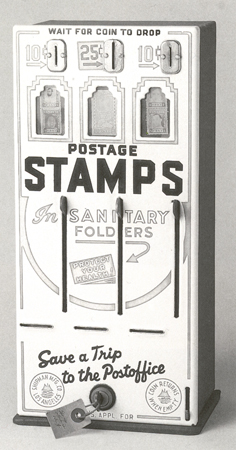
In 1963 Robert Watts used a stamp vending machine to vend "Fluxpost" stamps. I’ve only been able to find a picture of his machine, however, not what was inside it.
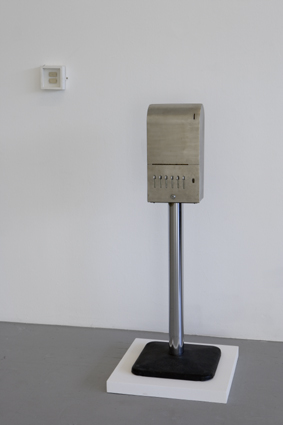
The Fluxus artists were the first artists I know of to do vending machine art. However, I'd be surprised if there weren't many others.
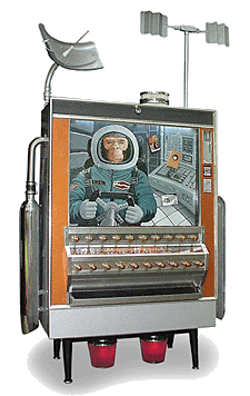
Art*o*Mat®
Started in 1997, the Art*o*Mat ® is probably the most
polished, professional, coolest and most successful art
vending machine out there. Better still, they give
artists a generous 50% cut of the sale. Art*o*Mat ®
repurposes cigarette vending machines, and the machines
are works of art unto themselves. They completely
redecorate and refurbish the old machines, making them
fresh and new while still honoring the historical
context of the period the machine was created in.
Check out their gallery! Currently they
have 82 machines around the US other countries!
Art*o*Mat ® just started selling stuff online.
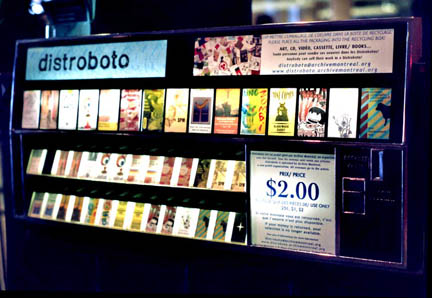
Distroboto, started in 2001, also uses . Remarkably, Distroboto vends for $2 and gives the artist a $1.75 cut! Unfortunately, (for those of us living outside of Montreal) Distroboto is run by Archive Montreal:
Archive Montreal appears to be totally focused on Montreal. You can only get Distroboto from vending machines in Montreal. This is a shame because their work looks so tantalizing:Archive Montreal is a non-profit organization founded in 1998 by local writers, artists and publishers. Its mandate is assisting in the promotion, distribution and preservation of local independent culture.
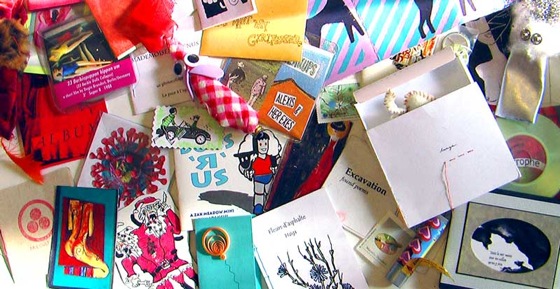
Hayvend Laboratories
Operating out of London, Hayvend Laboratories has a "no linking without permission" policy to their site (thus no link, no picture). Seems silly in this day and age, but... whatever. Google them. They've been at it since 1995 and have even been written up in Vogue!
Gumball Poetry
Gumball Poetry was published by Laura Moulton and Ben Parzybok from 1998 to 2006 in Portland, Oregon. Like Callithump!, they used 2" capsule toy vending machines to sell poetry and other contents. Smartly, their main focus was poetry, printed in black & white on plain paper. This would lower costs and reduce production time over the elaborate way we do it! They even included an actual gumball in the capsule, so even if you didn't like the poem, you still got your money's worth. Gumball Poetry had a good run of it, with 19 machines throughout 8 states in the Pacific Northwest. Happily for them, but unfortunate for the rest of us, Laura and Ben have moved on to other creative endeavors (like having children and writing books).

Snack Art
Back before the University of Maine, Orono, sold out it’s students by granting a vending concessions monopoly to Coca Cola, the vending machines were filled by independent contractors. Since Orono isn’t too far from the Canadian border, the contractors would have routes that went up into Canada. Sometimes, when they ran out of US products, the contractors would fill up slots with Canadian product. It was a kind of magic when you’d come across this. You’d find things you’d never heard of before, things that you couldn’t find anywhere but that one vending machine at that one moment. When that thing was gone, you’d never see it again. Somehow, those rare items always tasted better than the standard fare. The chocolates were made from real chocolate instead of the brown-dyed paraffin that passes for chocolate in the US, for example. Or you’d mirror mirror versions of the old standards like lime & black pepper chips instead of salt & vinegar. It was always a rare and special treat to find these things in the vending machines, and I’d always pump in my quarters when it happened because I knew I wouldn’t have another chance. When I came back, it’d be gone.
In Australia, there’s a vending machine that must be filled by contractor who’s route travels not just to nearby countries, but into parallel Earths. In these worlds the vending machines don’t sell just junk food. They sell artwork!
With Snack Art, Sydney, Australia’s Jane Naylor vends artwork alongside the usual tasty snack machine treats.
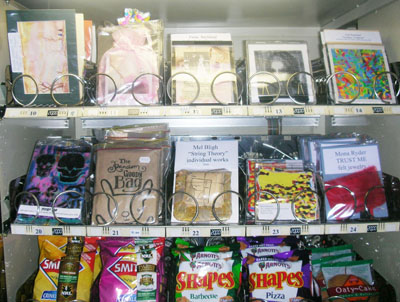
Jane has great ideas when it comes to vending art. For
starters, she’s using a snack machine to vend, which allows
her to set the prices of the artworks individually (unlike
capsule, stamp and other vending machines, where you’re
stuck at whatever price the machine vends at). She
convinced local vending business man Paul Long to provide
the vending machine. Since she’s eliminated this overhead,
she’s able to give 100% of the proceeds back to the
artists. I love the fact that she still vends snacks from
the machine, too. You can feed body & soul from one
machine!
And she’s got a great logo:
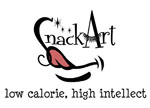
If I’m ever in Australia, I’m heading over there! If you’re
there now, you can find Snack Art at the located in the
Casula Powerhouse.
